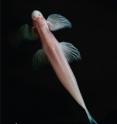NJIT researchers make a major cavefish discovery in Thailand
Researchers from New Jersey Institute of Technology (NJIT) have identified unique anatomical features in a species of blind, walking cavefish in Thailand that enable the fish to walk and climb waterfalls in a manner comparable to tetrapods, or four-footed mammals and amphibians. The discovery of this capability, not seen in any other living fishes, also has implications for understanding how the anatomy that all species need to walk on land evolved after the transition from finned to limbed appendages in the Devonian period, which began some 420 million years ago. This research is reported in a March 24 Nature Scientific Reports article, "Tetrapod-like pelvic girdle in a walking cavefish," by Brooke E. Flammang, Daphne Soares, Julie Markiewicz and Apinun Suvarnaraksha. Flammang and Soares, assistant professors in the NJIT Department of Biological Sciences, were assisted with the research by Markiewicz, an NJIT post-baccalaureate research volunteer in the Flammang lab at the university. Investigator Suvarnaraksha is a member of the Faculty of Fisheries Technology and Aquatic Resources of Maejo University in Thailand. The full text of their article is available at http://www.nature.com/articles/srep23711.
Speaking of the unique anatomical structures seen in the cavefish, Cryptotora thamicola, Flammang says, "It possesses morphological features that have previously only been attributed to tetrapods. The pelvis and vertebral column of this fish allow it to support its body weight against gravity and provide large sites for muscle attachment for walking." With respect to evolutionary significance, she adds, "This research gives us insight into the plasticity of the fish body plan and the convergent morphological features that were seen in the evolution of tetrapods."
Source: New Jersey Institute of Technology
Other sources
- Fish with pelvis built for walking discovered in Thailandfrom CBC: Technology & ScienceMon, 28 Mar 2016, 13:20:53 UTC
- Blind cavefish can walk and climb waterfalls like four-footed mammals and amphibiansfrom Science DailySat, 26 Mar 2016, 1:30:43 UTC
- Blind fish that crawls on land holds clues to evolutionfrom CBSNews - ScienceFri, 25 Mar 2016, 21:30:35 UTC
- Amazing Blind Cavefish Walks Up Rocks and Waterfallsfrom Live ScienceFri, 25 Mar 2016, 19:00:54 UTC
- Pelvic 'Boogie' Moves Blind Cavefish | Videofrom Live ScienceThu, 24 Mar 2016, 23:10:37 UTC
- Thailand's blind, walking cavefish can ascend waterfallsfrom UPIThu, 24 Mar 2016, 19:10:48 UTC
- Researchers make a major cavefish discovery in Thailandfrom PhysorgThu, 24 Mar 2016, 15:30:45 UTC
